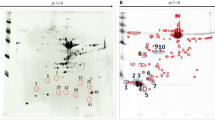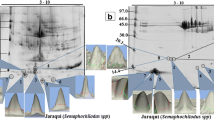Abstract
This study used metalloproteomic techniques to characterize mercury (Hg)-bound proteins in the muscle and liver tissue of Tucunaré (Cichla spp.) collected at the Jirau Hydroelectric Power Plant in Madeira River Basin, Brazil. The proteome of the muscle and liver tissue was obtained after two steps of fractional precipitation and separating the proteins by 2-D polyacrylamide gel electrophoresis. Hg was identified and quantified in the protein spots by graphite furnace atomic absorption spectrometry after acid mineralization in an ultrasound bath. Hg with a molecular weight <20 kDa and a concentration between 13.30 and 33.40 mg g−1 was found in the protein spots. These protein spots were characterized by electrospray ionization tandem mass spectrometry after trypsin digestion. From a total of 12 analyzed spots, seven proteins showing Hg biomarker characteristics were identified: parvalbumin and its isoforms, ubiquitin-40S ribosomal protein S27a, zinc (Zn) finger and BTB domain-containing protein 24, and dual-specificity protein phosphatase 22-B.


Similar content being viewed by others
References
Afonso C, Lourenço HM, Preira C, Martins MF, Carvalho ML, Castro M et al (2008) Total and organic mercury, selenium and α-tocopherol in some deep-water fish species. J Sci Food Agric 88:2543–2550
Arif SH (2009) A Ca2+-binding protein with numerous roles and uses: parvalbumin in molecular biology and physiology. BioEssays 31:410–421
Bakir F, Dambuji SF, Amin-Zaki L, Murthada M, Khalidi A, Al-Rawi NY et al (1973) Methylmercury poisoning. Science 181:230–236
Bebianno MJ, Santos C, Canário J, Gouveia N, Sena-Carvalho D, Vale C (2007) Hg and metallotionein-such as proteins in the black scabbardfish Aphanopus carbo. Food Chem Toxicol 45:1443–1452
Berbel P, Marco P, Cerezo JR, Felipe J (1996) Distribution of parvalbumin immunoreactivity in the neocortex of hypothyroid adult rats. Neurosci Lett 204:65–68
Berchtold MW, Brinkmeier H, Muntener M (2000) Calcium ion in skeletal muscle: its crucial role for muscle function, plasticity, and disease. Physiol Rev 80:1215–1265
Berkelman T, Stensted T (1998) 2-D electrophoresis using immobilized pH gradients: principles and methods. Edition AC (80-6429-60). Uppsala, Sweden: Amersham Biosciences Inc. manufacturer’s manual 100
Bloom NS (1992) On the chemical form of mercury in edible fish and marine invertebrate tissue. Can J Fish Aquat Sci 49:1010–1017
Bomar MG, Pai M-T, Tzeng S-R, Li SS-C, Zhou P (2007) Structure of the ubiquitin-binding zinc finger domain of human DNA Y-polymerase Z. EMBO Rep 8(3):247–251
Braga CP, Bittarello AC, Padilha CCF, Leite AL, Moraes PM, Buzalaf MAR et al (2015) Mercury fractionation in dourada (Brachyplatystoma Rousseauxii) of the madeira river in Brazil using metalloproteomic strategies. Talanta 132:239–244
Clarkson TW (1990) Human health risks from methylmercury in fish. Environ Toxicol Chem 9:957–961
Conesa A, Gotz S (2008) Blast2GO: a comprehensive suite for functional analysis in plant genomics. Int J Plant Genomics 1:1–12
Denhardt DT (1996) Signal-transducing protein phosphorylation cascades mediated by Ras/Rho proteins in the mammalian cell: the potential for multiplex signalling. Biochem J 318:47–53
Dorea JG (2003) Fish are central in of Amazonian riparians: should we worry about their mercury concentrations? Environ Res 92(3):232–244
Elsayed S, Aas K (1971) Characterization of a major allergen (cod). Observations on effect of denaturation on the allergenic activity. J Allergy 47:283–291
Farias LA, Fávaro DI, Santos JO, Vasconcellos MB, Pessoa A, Aguiar J et al (2010) Cooking process evaluation on mercury content in fish. Acta Amazon 40:741–748
Garcia JS, Magalhães CS, Arruda MAZ (2006) Trends in metal-binding and metalloprotein analysis. Talanta 69:1–15
GE Healthcare (2007) User’s Manual ImageMaster 2D Platinum 7.0, Edition AA
Givant-Horwitz V, Davidson B, Goderstad JM, Jahn M, Nesland JM, Tropé CG et al (2004) The PAC-1 dual specificity phosphatase predicts poor outcome in serous ovarian carcinoma. Gynecol Oncol 93:517–523
Harris RC, Snodgrass WJ (1993) Bioenergetic simulations of mercury uptake and retention in walleye (Stizostedion vitreum) and yellow perch (Perca flavescens). Water Pollut Res J Can 28:217–236
Hsu-Kim H, Kucharzyk KH, Zhang T, Deshusses MA (2013) Mechanisms regulating mercury bioavailability for methylating microorganisms in the aquatic environment: a critical review. Environ Sci Technol 47:2441–2456
Ikingura JR, Akagi H (2003) Total mercury and methylmercury levels in fish from hydroelectric reservoirs in Tanzania. Sci Total Environ 304(1–3):355–368
Jesus TB, Carvalho CEV (2008) Utilização de biomarcadores em peixes como ferramenta para avaliação de contaminação ambiental por mercúrio (Hg). Oecol Bras 12:680–693
Kobayashi A, Tanaka H, Haada Ym Ishizahi S, Nagashima Y, Shiomi K (2006) Comparison of allergenicity and allergens between fish white and dark muscles. Allergy 61:357–363
Lima PM, Neves RCF, Santos FA, Pérez CA, Silva MAO, Arruda MAZ et al (2010) Analytical approach to the metallomic of Nile tilapia (Oreochromis niloticus) liver tissue by SR-XRF and FAAS after 2D-PAGE separation: preliminary results. Talanta 82:1052–1056
Mailman M, Stepnuk L, Cicek N, Bodaly RAD (2006) Strategies to lower methyl mercury concentrations in hydroelectric reservoirs and lakes: a review. Sci Total Environ 368(1):224–235
Moraes PM, Santos FA, Padilha CCF, Vieira JCS, Zara LF, Padilha PM (2012) A preliminary and qualitative metallomics study of mercury in the muscle of fish from Amazonas, Brazil. Biol Trace Elem Res 150:195–199
Moraes PM, Santos FA, Cavecci B, Padilha CCF, Vieira JCS, Roldan PS et al (2013) GFAAS determination of mercury in muscle samples of fish from Amazon. Food Chem 141:2614–2617
Nevado JJB, Martin-Doimeadios RCR, Bernardo FJG, Moreno MJ, Herculano AM, Nascimento JLM et al (2010) Mercury in the Tapajós River basin. Braz Amazon 36(6):593–608
Neves RCF, Lima PM, Baldassini WA, Santos FA, Moraes PM, Castro GR et al (2012) Fracionamento de cobre em proteínas do plasma, músculo e fígado de tilápia do Nilo. Quim Nova 35:493–498
Offer G, Moos C, Offer R (1993) A new protein of the thick filaments of vertebrate skeletal myofibrils: extraction, purification and characterization. J Mol Biol 74:653–676
Pearson RG (1963) Hard and soft acids and bases. J Am Chem Soc 85:3533–3539
Pollard KM, Hultman P (1997) Effects of mercury on the immune system. Metal Ions Biol Syst 34:421–440
Santos FA, Lima M, Neves RCF, Moraes PM, Pérez CA, Silva MAO et al (2011) Metallomic study of plasma samples from Nile tilapia using SR-XRF and GFAAS after separation by 2D PAGE: initial results. Microchim Acta 173:43–49
Shevchenko A, Tomas H, Havlis J, Olsen JV, Mann M (2006) In-gel digestion for mass spectrometric characterization of proteins and proteomes. Nat Protoc 6:2856–2860
Silva FA, Cavecci B, Baldassini WA, Lima PM, Moraes PM, Roldan PS et al (2013) Selenium fractionation from plasma, muscle and liver of Nile tilapia (Oreochromis niloticus). Food Meas 7:158–165
Tusnády GE, Simon I (1998) Principles governing amino acid composition of integral membrane proteins: application to topology prediction. J Mol Biol 283:489–506
Universal Protein Resource (UniProt) (2015) Web page. Available at: www.uniprot.org. Accessed 18 Aug and 21 Dec, 2013
Urrutia R (2013) KRAB-containing zinc-finger repressor proteins. Genome Biol 231(4):1–8
Weiner JG, Spry DJ (1996) Toxicological significance of mercury in freshwater fish. In: Beyer WN, Heinz GH, Redmon-Norwood AW (eds) Environmental contaminants in wildlife: interpreting tissue concentrations. Lewis, Boca Raton, pp 297–339
Wilwert JL, Madhoun NM, Coughlin DJ (2006) Parvalbumin correlates with relaxation rate in the swimming muscle of sheepshead and kingfish. J Exp Biol 209:227–237
Acknowledgments
The authors thank the Brazilian research funding agency ANEEL/ESBR-P&D: 6631-0001/2012/Contract Jirau 004/2013, São Paulo State Research Foundation (Processes: 2012/24035-5 2010/51332-5 and 2013/21297-1), and Coordination for the Improvement of Higher Education Personnel (CAPES) for their financial support.
Author information
Authors and Affiliations
Corresponding author
Rights and permissions
About this article
Cite this article
Vieira, J.C.S., Cavecci, B., Queiroz, J.V. et al. Determination of the Mercury Fraction Linked to Protein of Muscle and Liver Tissue of Tucunaré (Cichla spp.) from the Amazon Region of Brazil. Arch Environ Contam Toxicol 69, 422–430 (2015). https://doi.org/10.1007/s00244-015-0160-9
Received:
Accepted:
Published:
Issue Date:
DOI: https://doi.org/10.1007/s00244-015-0160-9




